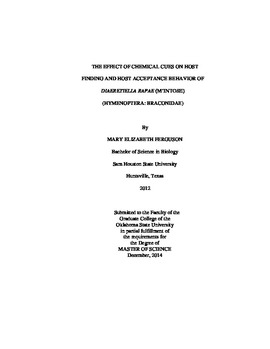| dc.contributor.advisor | Royer, Tom A. | |
| dc.contributor.author | Ferguson, Mary Elizabeth | |
| dc.date.accessioned | 2016-01-20T15:44:31Z | |
| dc.date.available | 2016-01-20T15:44:31Z | |
| dc.date.issued | 2014-12-01 | |
| dc.identifier.uri | https://hdl.handle.net/11244/25648 | |
| dc.description.abstract | In winter wheat (<italic>Triticum aestivum</italic>) in Oklahoma, aphid pest suppression occurs through the natural activities of the parasitoid wasp <italic>Lysiphlebus testaceipes</italic> (Cresson). As winter canola (<italic>Brassica napus</italic>) has become increasingly grown as a rotation crop with wheat, it has not experienced the same kind of suppression for its aphid pests, namely the turnip aphid, <italic>Lipaphis pseudobrassicae</italic> (Davis) and the cabbage aphid, <italic>Brevicoryne brassica</italic> (L.). The principle cabbage aphid parasitoid, <italic>Diaeretiella rapae</italic> (M'Intosh) is one of the possible means of biological control. Its behavior in relation to volatiles present in both wheat and canola has been tested to determine the likelihood of this parasitoid to be used in an integrated pest management program. Although it does not learn chemicals in its immature stages inside the aphid host, this wasp is greatly influenced by volatiles it is exposed to upon emerging from its host. Depending upon its emergence environment, <italic>D. rapae</italic> can be an effective means of biological control with parasitism rates comparable to that of <italic>L. testaceipes</italic> on aphids in wheat. It is limited by its ability to learn and respond to chemical cues that are different from its emerging environment, most notably when the environment changes from canola to wheat and it experiences a very low rate of parasitism. Because canola is planted for only 1-2 years consecutively these small populations of <italic>D. rapae</italic> may struggle to reach high enough densities to be considered an effective means of aphid pest suppression in canola. | |
| dc.format | application/pdf | |
| dc.language | en_US | |
| dc.publisher | Oklahoma State University | |
| dc.rights | Copyright is held by the author who has granted the Oklahoma State University Library the non-exclusive right to share this material in its institutional repository. Contact Digital Library Services at lib-dls@okstate.edu or 405-744-9161 for the permission policy on the use, reproduction or distribution of this material. | |
| dc.title | Effect of Chemical Cues on Host Finding and Host Acceptance Behavior of Diaeretiella Rapae (M'intosh) (Hymenoptera: Braconidae) | |
| dc.type | text | |
| dc.contributor.committeeMember | Giles, Kris L. | |
| dc.contributor.committeeMember | Elliott, Norm C. | |
| dc.contributor.committeeMember | Payton, Mark | |
| osu.filename | Ferguson_okstate_0664M_13646.pdf | |
| osu.accesstype | Open Access | |
| dc.description.department | Entomology (PhD) | |
| dc.type.genre | Thesis | |
